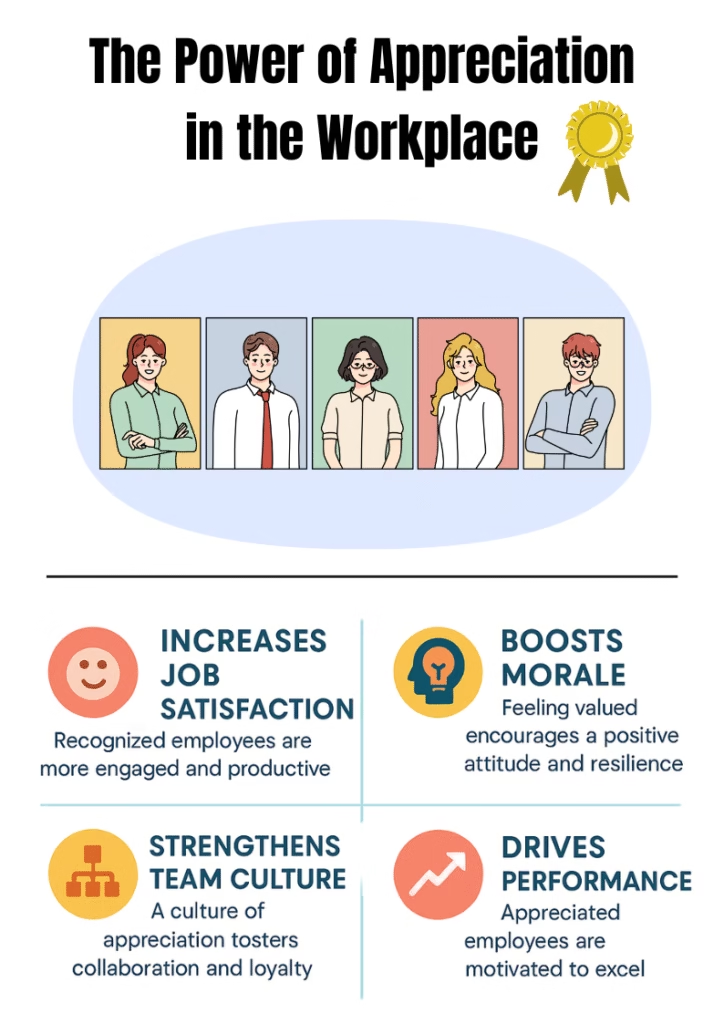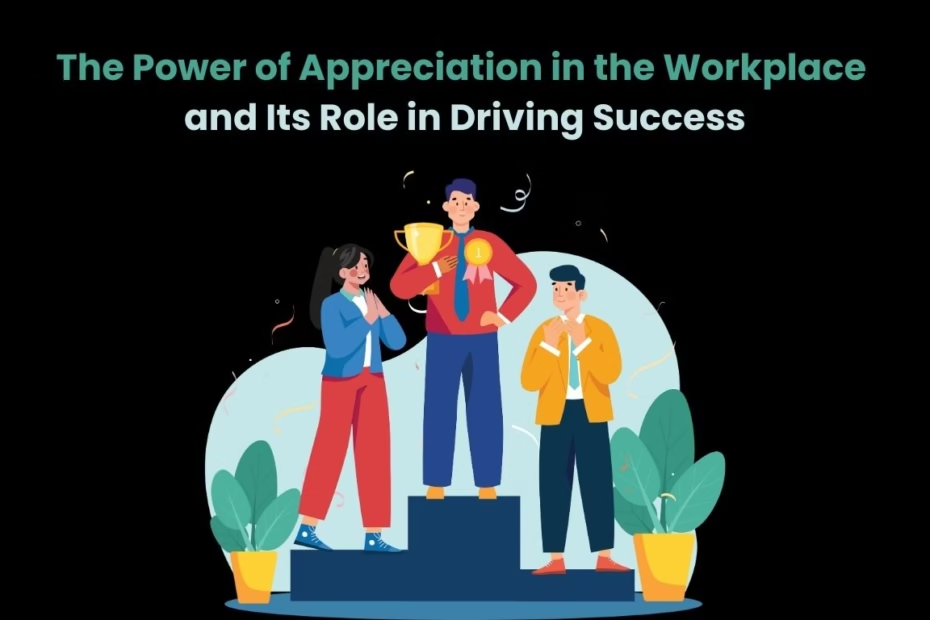Today’s workplace conditions mean that a little sincere appreciation can make a big difference to an organization. 70% of the global workforce say they feel disengaged which is why businesses are looking for ways to get their employees motivated again. Really, what employees want is recognition of what they do, not only their wages.
When people realize they are truly valued, they give more effort to what they do. This blog uncovers how appreciating strategy helps business by raising employee satisfaction, remembering principles and increasing profits through procedures you can use today.
Understanding the Science Behind Appreciation at Work
Appreciation helps much more than simply making someone happy. There are strong studies that show why being recognized plays a big role in shaping workplace actions and success.
Recognition that comes from the heart makes our brains release chemicals that make us feel good and connect us with others. The reaction in the brain helps you see work and colleagues in a positive light. That’s why the best employee recognition software helps companies build methods to trigger these good brain reactions by offering personal and timely appreciation.
Appreciation by others meets people’s basic needs to feel connected and valued. When people at work believe their contributions are recognized, they become bolder and more ready for innovation. Because of this, appreciation encourages staff to immerse themselves more which results in top-quality work that deserves continuing appreciation.
Intrinsic vs. Extrinsic Motivation
Although incentives are important, showing appreciation at work is especially meaningful because it energizes us from within. Employees become more motivated inside when they sense their unique contributions are valued, more than when just given money. Scientifically, appreciation is required for our brains and nerves to work well and reach our best.
Measuring the Business Impact of Employee Appreciation
Organizations often question whether there’s a tangible return on investing in appreciation initiatives. The data convincingly shows that there is.
Key Performance Indicators Affected
Appreciation and employee engagement are directly linked to measurable business outcomes. Companies with strategic recognition programs see improvements in productivity, quality metrics, customer satisfaction scores, and safety incidents. These indicators provide concrete evidence of appreciation’s impact.
Financial Returns on Recognition Investments
The cost/turnover ranges between 50 to 200% of an employee’s annual salary. Organizations with robust benefits of % and appreciation in the workplace report turnover rates 31% lower than companies without such programs, representing significant cost savings.
When measured properly, the business case for appreciation becomes undeniable, making it a strategic imperative rather than simply a nice gesture.
Core Benefits of Appreciation in the Workplace
Understanding the specific ways workplace appreciation drives organizational success helps leaders prioritize and implement effective recognition strategies.

IMAGE SOURCE: Canva
Enhanced Engagement and Performance
When employees feel valued, they bring their best selves to work. Recognition creates a positive feedback loop where appreciated employees put in discretionary effort that leads to better results. This increased engagement directly impacts your bottom line.
Strengthened Company Culture
Employee appreciation reinforces and amplifies your organization’s values when you acknowledge behaviors that exemplify them. This creates a clear connection between stated values and daily actions, making your culture more authentic and resilient, especially during challenging times.
Improved Retention of Top Talent
In today’s competitive talent market, feeling unappreciated is a primary reason good employees leave. Companies navigating executive recruitment can leverage strategic hiring practices to ensure that new leaders foster retention and strengthen organizational culture. By implementing consistent workplace appreciation practices, you create emotional connections that make it harder for competitors to lure away your best people.
Maintaining a culture of appreciation also requires ensuring that recognition practices align with essential legal and procedural requirements within the HR function. For organizations seeking to foster engagement while staying compliant, it’s important to address mandates such as hiring documentation and employee identity verification. Exploring best practices for HR compliance with I-9 & E-Verify can help your team seamlessly integrate appreciation initiatives without overlooking these critical workforce regulations.
The benefits of strategic appreciation extend throughout the organization, creating a foundation for sustainable success in numerous areas.
Effective Recognition Strategies for Different Work Models
As workplaces evolve, appreciation must adapt to different environments while maintaining its impact regardless of where people work.
In-Office Recognition Approaches
Physical workplaces offer unique opportunities for visible appreciation. Wall-of-fame displays, impromptu celebrations, and face-to-face recognition moments create powerful experiences. The key is making sure these moments don’t feel formulaic or rare.
Remote Team Appreciation Tactics
Virtual teams need deliberate, systematic appreciation since casual hallway “thank yous” aren’t possible. Digital recognition platforms, virtual celebration rituals, and shipped appreciation items help bridge the distance gap for remote workers who might otherwise feel invisible. You can use internal communication software to share these messages so no one feels left out or unseen.
Hybrid Workplace Solutions
The biggest challenge in hybrid environments is ensuring equal recognition experiences regardless of location. This requires thoughtful planning to avoid proximity bias, where in-office employees receive more recognition simply because they’re physically present and visible. Employee monitoring software can provide leadership with useful insights into their remote teams’ accomplishments, making it easier to recognize and reward high-performers.
As workplace models continue evolving, the principles of effective appreciation remain constant even as the delivery methods adapt to new environments.
Creating a Culture of Continuous Appreciation
For appreciation to drive meaningful results, it must be woven into the fabric of your organization rather than treated as a sporadic activity.
Leadership’s Essential Role
Leaders set the tone for employee appreciation by modeling recognition behaviors themselves. When executives and managers consistently express genuine gratitude, it signals the importance of appreciation throughout the organization and establishes it as a cultural norm.
Democratizing Recognition
While top-down recognition matters, peer-to-peer appreciation creates a multiplier effect throughout your organization. Implementing systems that make it easy for colleagues to recognize each other’s contributions builds community and strengthens relationships at every level.
The Impact of Micro-Recognitions
Not all appreciation needs to be grand or formal. Small, Micro-Recognition of recognition often has more impact than rare, large celebrations. Teaching people to notice and acknowledge daily contributions creates a continuous appreciation environment.
Building a culture of appreciation requires intention and consistency, but the cumulative impact of these efforts transforms organizational performance over time.
Implementing Recognition Technology Effectively
Modern technology offers powerful tools for systematizing and scaling appreciation across organizations of all sizes. The most effective employee recognition software includes social recognition capabilities, rewards management, analytics dashboards, and mobile accessibility. These features make appreciation more visible, equitable, and measurable throughout the organization.
For maximum adoption, recognition platforms should integrate with the tools employees already use daily. Look for solutions that connect with communication platforms, performance management systems, and HRIS to create a seamless experience.
Measuring Program Effectiveness
The best recognition platforms provide robust analytics on program usage, engagement patterns, and business impact. These insights help you continuously refine your approach and demonstrate the ROI of your appreciation initiatives.
Technology should enhance rather than replace the human element of appreciation, making recognition more consistent, accessible, and impactful across the organization.
Read More: How to Create a More Productive Office Space
Final Thoughts: Making Appreciation a Strategic Priority
Employee appreciation isn’t just a nice-to-have – it’s a business imperative in today’s competitive environment. The organizations that thrive understand that strategic, consistent recognition creates powerful results across every aspect of performance.
By implementing the approaches outlined in this guide, you’ll begin transforming your workplace through the systematic application of appreciation. Start small, measure results, and watch as recognition becomes a catalyst for greater engagement, stronger culture, and improved business outcomes.
Remember that genuine appreciation is both an art and a science, requiring both systematic approaches and authentic human connection to achieve its full potential.
Answers to Questions about Gratitude in the Workplace
Why does gratitude matter in the world we live in today?
When you take the time and effort to show appreciation to your employees (and your colleagues and maybe even your boss), you help strengthen your relationship, build your workplace culture, and create a clearer path toward performance. Beyond simply being polite, expressing gratitude is a motivating factor for engagement and innovation for organizations in increasingly complex situations.
How does gratitude lead to business outcomes?
Whether or not your employees feel appreciated can determine the level of commitment, motivation, and intentions of turnover they experience. Remember, all of these will lead to higher productivity (also increased productivity will lead to a better customer experience), reduce your hiring processes, and make it easier for the company to generate new production rates, leading to positive impacts on your profits.
What are the most effective ways to show gratitude in the workplace?
There are effective ways to show gratitude. You include (there are others): words of affirmation (verbal or written recognition), quality time (meaningful conversations), acts of service (helping with an employee’s work), gifts (personalized tokens of gratitude), appropriate professional acknowledgement in public settings (while ensuring it follows the introduction of the person being recognized).

